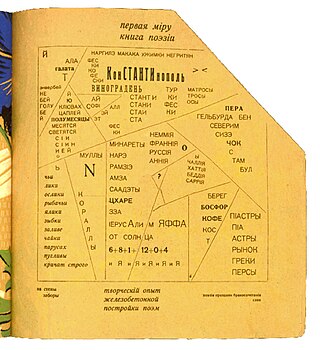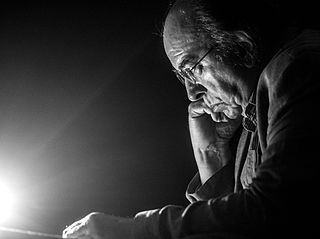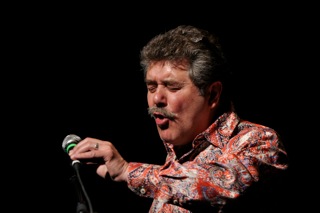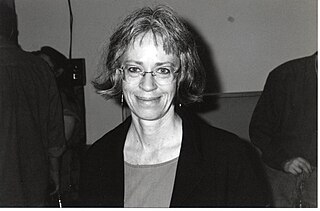Musique concrète is a type of music composition that utilizes recorded sounds as raw material. Sounds are often modified through the application of audio signal processing and tape music techniques, and may be assembled into a form of sound collage. It can feature sounds derived from recordings of musical instruments, the human voice, and the natural environment as well as those created using sound synthesis and computer-based digital signal processing. Compositions in this idiom are not restricted to the normal musical rules of melody, harmony, rhythm, and metre. The technique exploits acousmatic sound, such that sound identities can often be intentionally obscured or appear unconnected to their source cause.
Bill Bissett, commonly known as bill bissett, is a Canadian poet known for his unconventional style especially regarding unusual orthography and the use of visual elements.

Barrie Phillip Nichol, known as bpNichol, was a Canadian poet, writer, sound poet, editor, creative writing teacher at York University in Toronto and grOnk/Ganglia Press publisher. His body of work encompasses poetry, children's books, television scripts, novels, short fiction, computer texts, and sound poetry. His love of language and writing, evident in his many accomplishments, continues to be carried forward by many.

Concrete poetry is an arrangement of linguistic elements in which the typographical effect is more important in conveying meaning than verbal significance. It is sometimes referred to as visual poetry, a term that has now developed a distinct meaning of its own. Concrete poetry relates more to the visual than to the verbal arts although there is a considerable overlap in the kind of product to which it refers. Historically, however, concrete poetry has developed from a long tradition of shaped or patterned poems in which the words are arranged in such a way as to depict their subject.
Steven McCaffery is a Canadian poet and scholar who was a professor at York University. He currently holds the David Gray Chair at the University at Buffalo, The State University of New York. McCaffery was born in Sheffield, England and lived in the UK for most of his youth attending University of Hull.

Claude Gauvreau was a Canadian playwright, poet, sound poet and polemicist. He was a member of the radical Automatist movement and a contributor to the revolutionary Refus Global Manifesto.
Electroacoustic music is a genre of popular and Western art music in which composers use technology to manipulate the timbres of acoustic sounds, sometimes by using audio signal processing, such as reverb or harmonizing, on acoustical instruments. It originated around the middle of the 20th century, following the incorporation of electric sound production into compositional practice. The initial developments in electroacoustic music composition to fixed media during the 20th century are associated with the activities of the Groupe de recherches musicales at the ORTF in Paris, the home of musique concrète, the Studio for Electronic Music in Cologne, where the focus was on the composition of elektronische Musik, and the Columbia-Princeton Electronic Music Center in New York City, where tape music, electronic music, and computer music were all explored. Practical electronic music instruments began to appear in the early 20th century.

Mark Strand was a Canadian-born American poet, essayist and translator. He was appointed Poet Laureate Consultant in Poetry to the Library of Congress in 1990 and received the Wallace Stevens Award in 2004. Strand was a professor of English and Comparative Literature at Columbia University from 2005 until his death in 2014.
Derek Alexander Beaulieu is a Canadian poet, publisher and anthologist.

Tomás Rivera was a Mexican American author, poet, and educator. He was born in Texas to migrant farm workers, and worked in the fields as a young boy. However, he achieved social mobility through education—earning a degree at Southwest Texas State University, and later a Doctor of Philosophy degree (PhD) at the University of Oklahoma—and came to believe strongly in the virtues of education for Mexican-Americans.

Jean-Claude Éloy is a French composer of instrumental, vocal and electroacoustic music.

Stephen Cain is a Canadian poet and academic.
Mario Rivera was a Latin jazz saxophonist from the Dominican Republic. Besides saxophone, Rivera played trumpet, flute, piano, vibraphone, congas, and drums.

Marie Étienne is a French poet and novelist. In 2009, her book Roi des cent cavaliers and now translated into English as King of a Hundred Horseman won the PEN Award for Poetry in Translation. Étienne is the author of eleven books of poems and nine books of prose, which her translator Marilyn Hacker says "could be variously classed as fiction, memoir, and cultural history, some partaking of all three".
Paul Dutton is a Canadian poet, novelist, essayist, and oral sound artist.
Outriders Poetry Project, started in 1968, is a privately funded organization operating in Buffalo, NY that sponsors readings and publishes books by poets and writers based in the greater Niagara-Erie region.
grOnk, or GRoNK, was a Canadian literary magazine begun in 1967 by bpNichol and others (for example, David Aylward, David W. Harris, and Rah Smith. After the primary 8 series of 8 issues each were published, it was Nichol's efforts that maintained the irregular periodical, with guest editors including Nelson Ball, jwcurry, Steve McCaffery and R. Murray Schafer. An offshoot of Ganglia Press's Ganglia magazine, grOnk began with material gathered for Ganglia's sixth issue and became a monthly publication focusing on concrete poetry and "the language revolution" underway in Canada at the time, publishing a wide variety of "extralinear" writing from an international cast of contributors anchored in a context of parallel developments in Canadian literature. "GrOnk brought together British, Czech, American, Canadian, French and Austrian concrete and experimental practitioners..."
David UU, or David W. Harris, (1948–1994) was an accomplished concrete and experimental poet and an important small press publisher. Along with Bill Bissett and bpNichol, he was a pioneer of the concrete poetry movement in Canada, and perhaps the first Canadian poet to explore visual collage embodying literary, philosophical and language references. He also composed sound works, made 8mm short films, was a master collagist/montagist and performed in numerous performance art exhibitions.
"And I should mention to you that my last name is...just UU, the original form of the English letter W, which is also how it's pronounced." - David UU

Steven Ross Smith is a Canadian poet, sound poet, fiction writer, arts journalist and arts activist. He is best known for his fluttertongue poems, which have been published in six volumes. One of them, fluttertongue 3: disarray, won the 2005 Book of the Year Award at the Saskatchewan Book Awards. The fluttertongue poems have been described as a dance with words that pushes the boundaries of both language and poetry.

Judith Copithorne is a Canadian concrete and visual poet.









